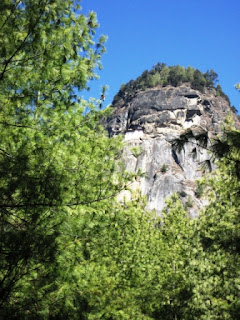Where Tigers Nest

About a month ago, the Professor came to visit, while working on a small project for another government agency in Bhutan. The great thing about being a professor at a prestigious university is that people all over the world want your help with things. The office he was assisting didn’t demand too much of his time, leaving plenty of time for exploring Paro, the location of Bhutan’s only airport, nearly two hours’ drive from Thimphu.
After visiting the spiraling halls of the National Museum, housed in a former watchtower, where we saw religious thangkas and statues, implements of war, and postage stamps, we climbed to Taktsang, or Tiger’s Nest, a monastery that marks the site of Guru Rimpoche’s second visit to Bhutan, back in the eighth century. Guru Rimpoche (Precious Master, also known as Padmasambhava) is the great saint who brought Buddhism to Bhutan. He mediated and subdued evil spirits throughout Bhutan. Monasteries, temples and shrines commemorate his influence, and are important pilgrimage sites in Bhutan and all over the Himalayas.
On his second visit to Bhutan, the Guru’s consort, Yeshe Tshogyal, took the form of a flying tiger to transport him. Thus, he was able to meditate in a cave improbably high up a cliff wall, overlooking the broad Paro valley. The monastery, one of Bhutan’s most important, that developed at this pilgrimage site burned down in the late 1990’s. In 2003, I made the two hour hike to the monastery, but was only able to watch the reconstruction, as logs were floated up the cliff via a cable system. (Getting the timbers up to the monastery site in the 17th century without cables or electricity would seem to require the miraculous powers of a Tantric master!)

This time, the reconstruction was complete, and the monastery glittered extravagantly in the winter sun. Though we had forgotten to get the requisite permits for entering the monastery, we were fortunate that two members of the five-person Spanish family ahead of us decided not to complete the hike, and their guide graciously included us on their permit.
The interior of the monastery, where no cameras are allowed, is truly spectacular. It seems that no expense was spared in restoring the monastery. Unlike many of the ancient monasteries where the colorful paintings have been muted by centuries of smoke and dust, Taktsang boasts a rainbow of vibrant color, with gilt highlighting the shape of every religious statue. The cave where Guru Rimpoche meditated can be view through a golden door decorated with ceremonial white kata scarves. Though dim and simple, the cave emitted an energy that tickled the hairs on the back of my neck.

The next day, we drove to the ruins of Drukgyel (Victorious Bhutan) Dzong, at the top of Paro Valley, where it guards a route from Tibet.
 Though there was little snow on the surrounding mountains, white Jhomolhari was visible behind the Dzong. The Bhutanese repelled Tibetan invaders many times from this fortress, which commands the valley above and below. Wandering in the ruins, I was struck by the similarity of the architecture to Spain’s Alhambra. I suppose scaring your enemies requires a similar aesthetic throughout the world.
Though there was little snow on the surrounding mountains, white Jhomolhari was visible behind the Dzong. The Bhutanese repelled Tibetan invaders many times from this fortress, which commands the valley above and below. Wandering in the ruins, I was struck by the similarity of the architecture to Spain’s Alhambra. I suppose scaring your enemies requires a similar aesthetic throughout the world. 


Comments